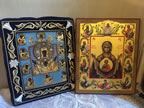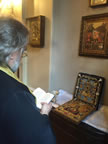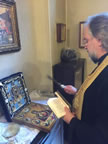
NEW YORK: February 3, 2017
A Painted Copy of the Kursk Root Icon of the Mother of God "of the Sign” is Consecrated for Moscow’a Znamensky Church in Novospassky Monastery
 On Thursday, February 2, 2017, Protopriest Andrei Sommer, Senior Priest of the Synodal Cathedral of Our Lady “of the Sign” in New York and Vice President of the Synodal Youth Department, consecrated a painted copy of the Kursk Root Icon of the Mother of God "of the Sign" in the altar of St Sergius of Radonezh Chapel. Upon the conclusion of the consecration ritual, the copy was placed upon the original Kursk-Root Icon. On Thursday, February 2, 2017, Protopriest Andrei Sommer, Senior Priest of the Synodal Cathedral of Our Lady “of the Sign” in New York and Vice President of the Synodal Youth Department, consecrated a painted copy of the Kursk Root Icon of the Mother of God "of the Sign" in the altar of St Sergius of Radonezh Chapel. Upon the conclusion of the consecration ritual, the copy was placed upon the original Kursk-Root Icon.
 The newly-consecrated icon will be delivered to Zamensky Church (dedicated to the Znamensky type of icon of the Mother of God, referred to as “of the Sign”) at Novospassky Monastery in Moscow. Last year, the monastery hosted an exhibition dedicated to the White Movement of Russia, jointly organized with the Union of the Descendants of the Russians of Gallipoli. The exhibition revealed the heroism of the participants of the White Movement, how they continued to struggle against all odds for the Fatherland, even after they found themselves far from Russia, staunchly preserving their ideals and traditions. A special section of the exhibit was devoted to the “Hodigitria of the Russian Diaspora,” the Kursk Root Icon of the Mother of God "of the Sign,” its history, miracles associated with it and its importance to Russian emigres. The newly-consecrated icon will be delivered to Zamensky Church (dedicated to the Znamensky type of icon of the Mother of God, referred to as “of the Sign”) at Novospassky Monastery in Moscow. Last year, the monastery hosted an exhibition dedicated to the White Movement of Russia, jointly organized with the Union of the Descendants of the Russians of Gallipoli. The exhibition revealed the heroism of the participants of the White Movement, how they continued to struggle against all odds for the Fatherland, even after they found themselves far from Russia, staunchly preserving their ideals and traditions. A special section of the exhibit was devoted to the “Hodigitria of the Russian Diaspora,” the Kursk Root Icon of the Mother of God "of the Sign,” its history, miracles associated with it and its importance to Russian emigres.
 In the northwest corner of the Transfiguration of the Savior Church is a chapel devoted to this holy icon. The “Znamensky” image of the Mother of God was also an heirloom icon of the Romanov Dynasty-Tsar Michael Romanov built the church above the burial site of Romanov boyars, his uncles, brothers of Patriarch Philaret, his father: Alexander, Vasily, Mikhail and Ioann Nikitich. In the northwest corner of the Transfiguration of the Savior Church is a chapel devoted to this holy icon. The “Znamensky” image of the Mother of God was also an heirloom icon of the Romanov Dynasty-Tsar Michael Romanov built the church above the burial site of Romanov boyars, his uncles, brothers of Patriarch Philaret, his father: Alexander, Vasily, Mikhail and Ioann Nikitich.
In 1791, the original church was demolished due to its age. Later that year, Prince Sheremetiev built a new church near the site dedicated to the Znamensky Icon of the Mother of God. The new church was designed by the architect Nazarov, a colleague of the renowned master Bazhanov. It was under construction for four years, and on January 15, 1795, was consecrated by Bishop Mefody of Voronezh, the former abbot of Novospassky Monastery.
In 1812, the French invaders turned the church into a stable, and in 1813, the two-story church was re-consecrated. The lower church contains crypts. Under the altar is the crypt of the Sheremetiev family, and the Lobanov-Rostovsky, Cherkassky, Sitsky and Urusov princely families are likewise buried there.
During the first years of the Soviet regime, the monastery was transformed into a woman’s prison, later a “correctional labor camp,” for political and other prisoners. Znamensky Church was turned into a crowded building of prison cells. In the 1930’s, during a new wave of oppression, death-row prisoners were taken to Znamensky Church allegedly for medical treatment but executed there instead. After World War II, the building was turned into an alcohol-rehabilitation center. In 1967, thanks to renowned artist Pavel Korin, the clinic was closed. Interior restoration work is now under way.

|